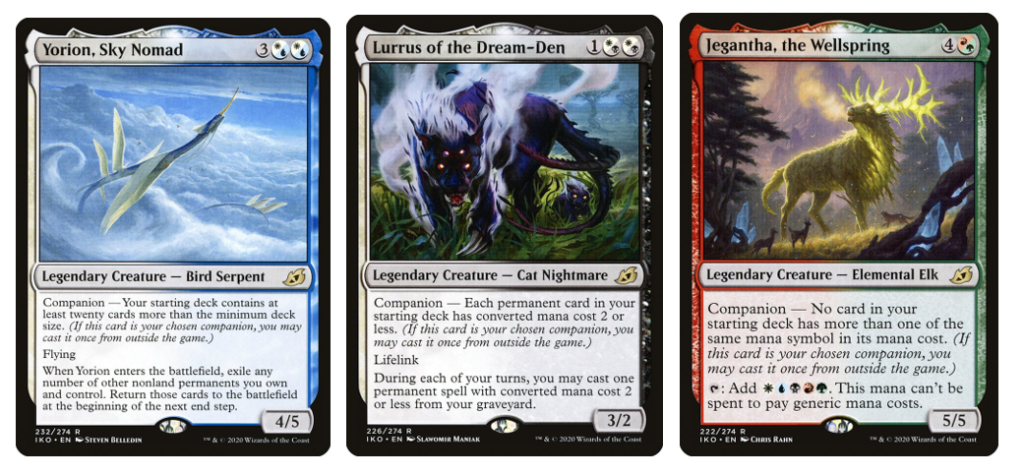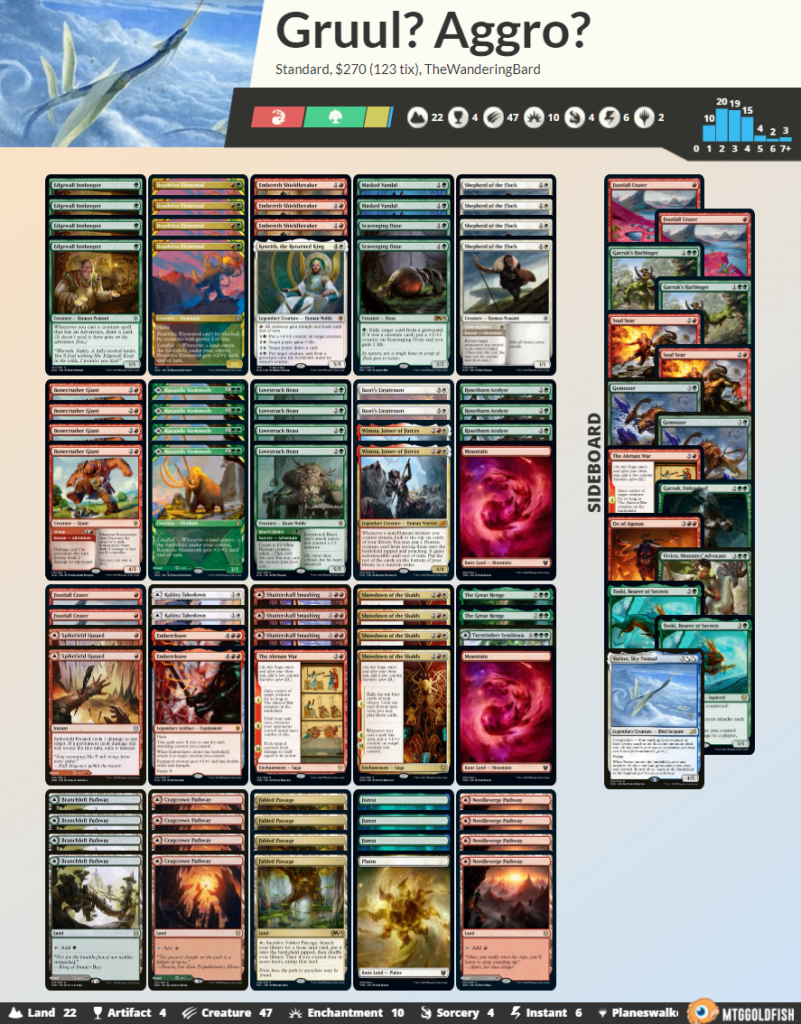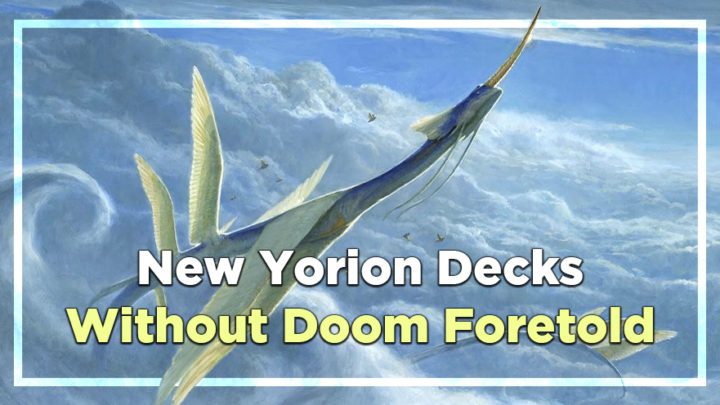The Magic community has had its frosty mitts on Kaldheim for a couple weeks now, and we’re starting to notice the effects filtering through into the Standard metagame. With some completely fresh mechanical possibilities and a high power level, there are several new cards and shells with potential, even once the set’s honeymoon phase fades.
But the depth of the pre-existing card pool means that the best strategies in pre-Kaldheim Standard are likely still the best post-Kaldheim. And one card in particular is still flying high above the rest of the pack: Yorion, Sky Nomad.
THE LAST OF THE COMPANIONS
With some of the more blatantly busted threats banned out, Yorion is probably the best card currently in Standard. The Sky Nomad’s biggest upside is that it has no downside, and in a min-maxing game like Magic, that’s incredibly dangerous.

The companion mechanic attracted huge skepticism thanks to this “free card” design, forcing WotC to enact the “companion tax” errata. But that nerf barely touched Yorion, which was already designed to play the long game and act as a value-adder rather than a key tempo play for its archetype. Now, aside from a smattering of Lurrus and Jegantha decks, there is now only one way to benefit from the bonus card companion offers: all roads lead to Yorion.
While there is ostensibly some opportunity cost in reworking an existing 60-card deck to fit Yorion, in practice, the quality of the Standard card pool is high enough to easily find (on average) ten extra spells that fit your game plan without diluting it. The cost is almost exclusively felt in deck-building, while the benefit in-game is extremely noticeable. You almost never see this kind of thing in Magic, so it’s almost surprising Yorion hasn’t already fully taken over the format.
BUILDING AROUND THE BIRD SERPENT
So far during its life in Standard, there have been two or three recognizable flavors of Yorion deck. Traditional control lists have often picked it up as a “free” body regardless of how many permanents they have to synergize with its blinking ETB trigger. On the other hand, Esper Doom decks have shown the power of a full build-around, with cheap, sticky artifacts and enchantments to generate a shower of free resources each time Yorion triggers. They usually feature Doom Foretold and Dance of the Manse as extra payoffs.

Lastly, there are the more traditional midrange lists that try to contest the board through high-quality threats and two-for-ones instead of sweepers. These are usually base-white or green-white to utilize the most powerful effects in this mold: Skyclave Apparition and Elspeth Conquers Death. The ability of the latter to also bring back a dead Yorion and set off another crushing wave of value is a defining trait of this list, and other non-blue versions which rely on the companion as their main resource engine.
WAIT, WHAT’S THE CATCH HERE?
But this is only the tip of the iceberg, as far as I’m concerned. The big lesson of Yorion’s time in Standard so far has been “your deck is probably better with Yorion and ten more spells.” Why should there only be one or two popular archetypes playing this card when the advantage it provides is so unique, free and generally strong?
Of course, there’s a sliding scale of how much value the Sky Nomad can offer a specific deck. A sideboard Yorion only makes its presence felt well into the game, so decks that like to take their time and have strong inevitability will use it best. Obviously, Yorion also scales with the number of useful permanents it can blink beneficially, as well as the number of ways you have to recur the Bird Serpent itself. Lastly, decks that otherwise lack large bodies or flying creatures will benefit more from having access to that in a pinch.
But my hunch is that even the minimal amount of value from playing Yorion as a companion will improve basically any Standard deck compared to the 60-card version. And since I like to make a point, I brought back some Yorion-happy decklists from the near-future to show you what you can expect once the rest of the world accepts our Sky-Nomadic savior.
UB ROGUES
One unanticipated benefit of Yorion in Rogues is access to a reasonably sturdy blocker.
While UW Control adopted Yorion very early on, recent UB strategies have been more closely associated with Rogues. But there’s no reason we can’t put Yorion in that deck, too! In fact, blinking your rogues can be a sneaky boost to the mill win condition, threatening a combo kill reasonably often.

If you call up Yorion to blink a full board of rogues, they will all re-enter at once and trigger each other for full effect. Each Thieves’ Guild Enforcer will mill opponents for two cards per rogue, including itself, which is already quite a lot. But then you have to consider Glasspool Mimic. Not only is the clone side a way to re-trigger Yorion once in play (albeit at the cost of one Yorion), but if you blink any Mimics they can re-enter as extra Enforcers, multiplying your mill further. And if you have one of those Mimics re-enter as Yorion itself, then you get to re-flicker your board and essentially double your mill again!
This extra mill doesn’t happen until the opponent’s next end step, and you won’t have the creatures to block during that time, so be careful not to get blown out. But particularly against slow decks — or rival 80-card piles — this might get you over the line. Sublime Epiphany, Orvar, the All-Form, and especially Mystic Reflection can all squeeze into the list if you want to make this combo more potent and reliable.
WB MIDRANGE
Yorion supports a whole mess of slightly divergent WB value-attrition strategies. You’d be hard pressed to fit them all in one deck, even with an 80-card list. Best of all, the bedrock of this deck is all cards from Kaldheim, so you can enjoy the refreshing comfort of Yorion while still getting to try the new fun stuff.

One direction we can go with WB is to revisit last year’s short-lived “Yorion Rats” archetype. Not only are we back up to two ETB-discard two-drops with Elderfang Disciple and Acquisitions Expert, but Tergrid (and particularly her Lantern) has joined Liliana, Waker of the Dead as a critical second payoff for emptying your opponent’s hand. Remember that if you blink some of your “rats” with Yorion, you can also turn the Lantern back into Tergrid herself and get a big swing off those discard triggers!

This WB Angels deck also uses Yorion to go over the top in key situations, albeit in a more traditional midrange shell with significant aerial pressure. Kaldheim’s design team decided to make the two best angel tribal payoffs enchantments with ETB triggers, which all but forces us to head in the Yorion direction to fully utilize them.
We can use Pyre of Heroes for advantage with both angels and clerics, especially upgrading our two-drop clerics into the super-powerful Righteous Valkyrie — or into Vito for a sudden kill. Speaking of sudden Vito kills, our single Haunting Voyage is a lethal backup plan in a long game, where casting it for “cleric” should end things on the spot if Renegade Reaper has loaded our graveyard. With a number of spicy one-ofs already in the deck, Grim Tutor makes it more likely we can grab out the right stuff in a pinch — and we should definitely have the life for it!
ONLY HAPPY ENDINGS
Speaking of having the life, Yorion is able to take an even more vital role in a mono-white control build. Here we are fully leaning on Elspeth Conquers Death and Skyclave Apparition, with plenty more lifegain to handle creature decks until Doomskar can wipe away their gains.

Barring mass artifact removal (which we can potentially dodge with Flicker of Fate and Shepherd of the Flock), Cosmos Elixir will potentially run over any opposition, converting our anti-creature plan into an anti-control plan. And instead of the Haunting Voyage for inevitability, this time we’re working towards living Happily Ever After with our tutorable, “dual color” companions and miscellaneous card types.
GRUUL ADVENTURES: THE FORBIDDEN YORION DECK?
So far, we have built some pretty typical Yorion lists. They may be different colors and feature some unusual card choices, but they still fall into the expected categories: controlling lists that can plunge Yorion onto an empty board, or grinding midrange plans where Yorion pushes your value to a game-winning level.
But when I say Yorion is good in everything, I mean EVERYTHING.

Between Edgewall Innkeeper, The Great Henge and now Showdown of the Skalds, even creature “aggro” decks are as much about out-valuing your opponent and building a huge board as they are presenting an immediate clock. In fact, with the way the meta is trending, most green decks are just dumping huge scaling body after huge scaling body onto the board until they overwhelm the competition.
So, what happens when we step three paces ahead of the meta and create the greediest aggro deck possible?
Never running out of pressure is amazing. This is the turn AFTER they swept me with Ugin!
WELCOME TO THE YEAR OF YORION
Okay, this was a fun thought experiment — and I won almost all my games — but do I actually recommend Putting Yorion In Everything? As long as the current metagame holds, I would sincerely say yes!
Yorion might not improve literally every deck, but in the current meta where most matchups are won by sheer weight of cards, it’s hard to justify not playing a free creature that ranges in impact from “nice” to “backbreaking.” It’s not just that so many cards provide incidental ETB value to combo with Yorion, it’s that removal has become so one-size-fits-all.
Permanent-based removal options like Skyclave Apparition, Elspeth Conquers Death, Planeswalkers, and adventure creatures guarantee two-for-ones; with a body attached, you can sling a ton of them in every deck. More traditional removal spells like Bloodchief’s Thirst, Heartless Act and Drown in the Loch scale up to hit any and all targets with ease. This isn’t by mistake; removal and sweepers simply have to be this strong to justify their existence as Constructed Magic becomes faster than ever before.
The only rule of Yorion Standard: he who greeds hardest, greeds best.
With such a high saturation of answers available for every threat, we’re almost back to evaluating cards like in the Oko meta: where the text on a card barely matters, except for how it forces the opponent to trade removal for it, and how it guarantees that you will be ahead on that trade. Until the removal in Standard is scaled back or burn-based aggro decks emerge to punish the durdling, we’re all just living in the Sky Nomad’s world. You may as well jump on it!

Tom’s fate was sealed in 7th grade when his friend lent him a pile of commons to play Magic. He quickly picked up Boros and Orzhov decks in Ravnica block and has remained a staunch white magician ever since. A fan of all Constructed formats, he enjoys studying the history of the tournament meta. He specializes in midrange decks, especially Death & Taxes and Martyr Proc. One day, he swears he will win an MCQ with Evershrike. Ask him how at @AWanderingBard, or watch him stream Magic at twitch.tv/TheWanderingBard.

